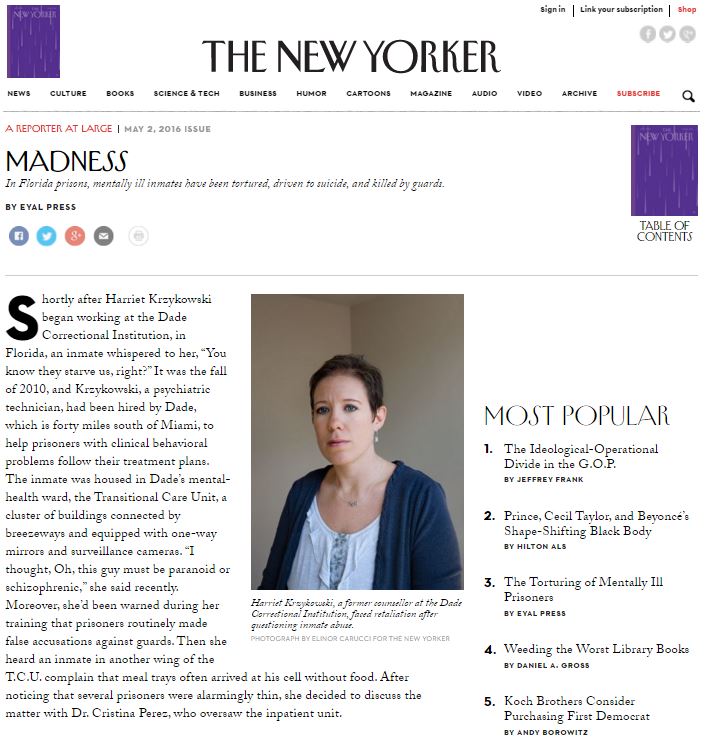This week’s issue of the New Yorker examines the treatment of people diagnosed with mental health issues in Florida’s prisons. The horrifying stories of prisoners tortured, killed by guards, and driven to suicide while staff looked away reached the public only through the work of investigators and whistleblowers.
-
An American Tragedy
Women In Jail; invisible, insane in pain and sterilized
article 2 by Margaret Altman MSW
I find that the contents of “delusions” are so rich and full of information that the very term delusion disparages and hides their relevance. In my work with emotionally distressed individuals in the Los Angeles Jail the locked wards and ERs I listen attentively to the wishes, needs and experiences that are woven into the fabric of the person’s life material in creative ways that have true meaning and importance.
In the correctional system I have written about the reality that having and expressing this material can and will precipitate abuse, diagnosis and medication. Therefore I never used the term. But others did and as the leader of the Psychiatric Evaluation Team there was a very turbulent 6 month period of time when this term became more dangerous and a label that could be used to mask the terrible truth of coerced sterilization.
A Federal Investigation team was on site for 6 months looking into the case of an inmate who, although diagnosed with Paranoid Schizophrenia, had been mistakenly released in the middle of the night, alone, without notifying his family and in a state of “Delusional Suicidality”. He went to Union Station (1 block from the jail) lay across the tracks and both legs were amputated. His brother, a prominent attorney, called for an investigation. Every “delusional” inmate was considered a potential time bomb.
At this time I was called to evaluate a woman who was one of several who were sent from State Prison for court appeals on their long sentences. One of these women, serving 15 years, was the spokeswoman for the other 3 and she had refused to attend her hearing in court because she was afraid that she would be coerced into being sterilized as a condition of early parole. This was the statement that was heard in the courtroom to the dismay of all in attendance. The word sterilization had never issued from the lips of a female inmate in court and it echoed eerily.
In front of the judge and all in attendance she became panicked and cried but agreed to go back to her cell without incident. The woman’s statement and her anxiety were according to the expert jail psychiatrists and 2 psychologists due to her “delusion” about sterilization, and it needed to be taken care of as quickly as possible. My team was called in to consult and lay the issue to rest with a diagnosis of “delusional disorder”.
I met with Mary who was an African-American woman of 30, incarcerated on a 15 year term for car theft, burglary and assault charges. Mary had 4 children, all in foster care and was physically healthy except for asthma on occasion.
Her sentence in prison included a mental health component because she had a history of “depression”. She was prescribed Zoloft and Abilify and she met with the prison psychiatrist on a monthly basis. In her data base was a notation about alcohol abuse and cocaine dependence. There was no record of delusional symptoms and her court appearance was supposed to be a routine plea by her public defender for a diversion program instead of the full sentence.
Mary was a well-groomed woman, in a tiny cell with a cell-mate who was about her age and also neat and clean as was the cell itself. Mary had a worried expression on her face, she sat on her bunk with her hands clasped tightly together. She had good eye contact and spoke quite clearly. When I introduced myself she indicated that she had been informed that I was coming and she knew that it concerned her behavior and statements in the courtroom. When I asked her if she felt safe in talking to me about what she was experiencing she said that the jail was not a safe place to say anything but that she would tell me what could and hope that she was not getting herself into “trouble”.
Mary said that in state prison, the women were very concerned about inmates who related that they had had tubal ligations as part of their plea bargains and some of them were very upset afterwards. She believed that they had agreed to the procedure in order to cut years off of their terms but that they had guilty feelings and had not had time to think about the decision or talk to a counselor or priest. I asked how she felt about this procedure and she became more anxious as she told me that her boyfriend wanted a child of his own with her and that she was afraid that he would leave if she were sterilized. This was a momentous decision for her and with the court date looming she was feeling overwhelmed. Mary’s cell mate nodded during this discussion and indicated that the “gossip” about the sterilization had polarized the women in prison and that there were arguments and physical altercations between groups who were for or against using this strategy for early release.
With this conversation and my observations I was able to conclude that Mary was not delusional and that I would not recommend a different diagnosis or medication. This was probably not what was hoped for by those who were trying to assuage the Federal investigators roaming the jails but I had my professional conscience to deal with. Thus ended my assessment obligation but not my concerns about the use of sterilization in plea bargaining and its impact upon incarcerated women who were already under severe stress and taking medication. My recommendation to Mary was that she contact the Patient Advocate Office and I gave her the name and number of a helpful advocate who would come in and speak with her.
I called her Public Defender who was evasive about discussing her case but told me that the court looked favorably upon women who “requested birth control” while incarcerated. He denied that this was part of a plea agreement although he indicated that it had been in the recent past. I informed him that his client was feeling pressured and needed to discuss her options with family, counselors and have time to consider her decision.
Mary was sent back to prison without the procedure and had a court date set for 2 months later. I had no further referrals related to this issue and was slowly able to piece together a history of coerced sterilization of a vulnerable female population that was considered to be “feeble minded” or “retarded”. This is part of American history (and may still be going on) that involved women inmates as well as women minorities in communities across the country. This is a vulnerable population of women in emotional pain who were poor, African American, and Hispanic with no resources and they were and may still be the targets of a vicious eugenics policy vigorously endorsed and promoted by public health officials and many others.
The background of American eugenics is a long and twisted tale that began when a sterilization law was in put into effect in California in 1909 possibly lasting until 1979. According to the reports cited at the end of this article this law was responsible for thousands of forced sterilizations of “mentally deficient and “feeble minded” women who were incarcerated in State Prisons, State Hospitals and General Hospitals. The public health sector and eugenics programs conspired to improve the quality of society in this barbarous manner and also to reduce the welfare lists and the population within the State facilities.
California prior to 1964 had the largest number of sterilizations in America and almost 60% were considered “mentally ill” and 35% were deemed “mentally deficient”. Many records have been lost or altered and the numbers may be higher. The first sterilization law passed in 1909 and the rate of procedures (tubal ligations) increased through the 1950’s. Subsequent amendments to the 1909 law broadened the scope of this legislation) allowing for a wider range of people to be sterilized. Anyone who was afflicted with hereditary insanity or incurable chronic mania or dementia could be sterilized. This law also established the State Lunacy Commission, which had the power to order sterilizations. ). There was no legal mechanism for patients to challenge the sterilization order, no written notification required to be sent to the patient of family, and no opportunity for a hearing that the institutional level
These laws, combined, allowed eugenic sterilizations to occur in the state of California through 1964.
In sum the 1909 law was aimed specifically at those in prisons and with mental disabilities that caused them to be institutionalized. Of those with mental disabilities, the law targeted patients in state hospitals and institutions of the feeble-minded. In terms of the prisoners, the law singled out those who were inmates for life, showing “sex or moral perversions”, or were certain repeat offenders . The 1913 law expanded to target all inmates in state hospitals or homes for the feeble-minded (except voluntary patients in state hospitals), as well as all repeat offenders in state prisons . The 1917 amendments greatly expanded the groups targeted even further to include those who had hereditary mental diseases, “those suffering from perversion or marked departures from normal mentality” and those with sexually-transmitted diseases . These two later laws expanded to include virtually any individual deemed unfit. About 70% of all sterilization was performed on people who were labeled mentally ill .
The goal of this legislation was to use sterilization as a tool with a broad range of applications, all of which were applied to prevent the procreation of undesirable traits, overcrowding of state institutions, and to alleviate fiscal constraints on the state.
Mental deficiency was a very broad term, including everything from the socially undesirable traits such as sexual promiscuity, to schizophrenia. These included alcoholics, epileptics, individuals with Down’s syndrome, the insane, and those who were manically depressed. The range of those targeted was expanded as the result of the laws over the years. These individuals were disproportionately female and racial minorities. Mexicans and African Americans were also disproportionately sterilized. Inmates in prisons, especially those whose crimes were sexual in nature, were targeted in the early years of the program. Later, the focus shifted primarily to target those with mental illness.
One last past historical note; Sonoma State Home that was established in 1884 for mentally disabled children set the stage for sterilization of women and it became a world-wide example of eugenics before WW2. This state facility focused upon women inmates who were deemed mentally deficient due to having children outside of marriage and thus threatening the purity of the race. This facilities sole purpose was to sterilize and release these women and they conducted dangerous tests and trials into the 1960s such testing including radiation and dose experiments inside of mental institutions did not require consent forms. Deaths and countless injuries resulted from these practices. This facility remains open today as the Sonoma Development Center.
More recently, there have been reforms in the domain of informed consents, a wait period between the agreement for sterilization and the procedure and safeguards for doctor’s signatures.
However this is not sufficient when one considers the emotionally distressed women in miserable prison cells, on medication, without family and friends at her side and faced with daily abuse and stigma.
For Mary and other inmates the sterilization issue is not past history, it is current affairs as a recent article in the Huffington Post points out. The Huffington Post article is based upon the recent CIR report (2013 cited below) and states that Doctors illegally sterilized at least 148 female California inmates, according to a new report. Inmates who spoke with the Center for Investigative Reporting said they were coerced by doctors into getting tubal ligation surgeries. The sterilizations allegedly took place between 2006 and 2010 at the California Institution for Women in Corona and Valley State Prison for Women in Chowchilla, now a men’s prison, according to CIR. It is alleged that Doctors conducted the surgeries “without required state approvals,” and inmates and prison advocates said they were aimed at pregnant prisoners who were “deemed likely to return to prison in the future,” CIR found. One of the doctors involved told the CIR investigators that the sterilization would help women who, due to Caesarian sections, could develop medical problems in the future.
In yet another article published in April of this year; Incarcerated Women Fight For Human Rights in California Prisons, a bill SB 219 was proposed and backed by reform groups to support Alternative Custody Programs for incarcerated women with children and does not allow for women to be denied the program if they have any type of medical or mental health condition. In the past we have seen that women with diabetes or with any type of mental health condition, with dental issues, have actually been denied the program.
In addition and of extreme importance this article states that Justice Now (a reform organization) was able to pass an anti-sterilization bill to make sure, or tocreate safeguards so that this won’t happen to women in the future.
Members of Justice Now allegedly heard from many of the incarcerated women that were sterilized was that they would go in to the healthcare facility with maybe some issues of cramps or any, any type of issue that they were experiencing. Some of them didn’t know that they had actually been sterilized until they were released from prison and were actually trying to have children and realized, when they went to the doctor again, or their medical practitioner, that they had been sterilized.
Justice Now was able to get a hold of documents that were able to be the fuel to focus this bill and really pass it unanimously. Right now Justice Now believes it’s the Board of State and Community Corrections are responsible for making sure that this doesn’t happen in the future.
The future must be now for vulnerable people who continue to face abuses that are masked as altruistic medical procedures or excused as historical mistakes or hidden away behind locked cell doors. Almost every rock in the systems of care and corrections has a snake lurking underneath it and they seem to slink away only to return to the nest.
The reform groups and advocacy organizations are doing their enormous part in changing legislation and we must support their efforts and expose the abuses consistently and passionately.
Margaret Sanger wrote; “No woman can consider herself free who does not own and control her body” This is true for all human beings. The laws that should protect us are often out-dated, cruel to vulnerable groups and these laws enable the perpetuation of crimes against minorities and marginalized people. Legislation must be monitored and challenged so that it enhances freedom and dignity and does not destroy it. As we fight to control our lives we must fight to be part of defining the laws that are already in place and those that are being considered. Each person plays a part in the construction of a national fabric that will disable coercion, discrimination and create an environment of equality, inclusion and hopefulness. -
Why is it so hard to fire abusive prison guards? Because they’re unionized. Here’s an eye-opening account of one abusive corrections officer’s …
http://www.the-american-interest.com/2015/09/28/public-unions-and-sadistic-prison-guards/Do Correctional Facilities Attract Sadists?
It seems certain professions exist that attract or reject specific personality types. The vegan would avoid employment at the meat processing plant. The guitarist might open a music store. The police officer — and this is being generous — may be attracted to the mythos of public service. But what of the correctional officer, the prison guard? What type of personality is attracted to warehousing human beings? https://defacingcurrency.wordpress.com/2014/05/16/sadistic-prison-guards/comment-page-1/
-
And this is above and beyond mass forced drugging, which is not “torture” but “business as usual.”















